Under Armour Bundle
How did Under Armour go from a basement idea to a global sports giant?
Imagine a world where athletic gear actively enhances performance. That's the vision that sparked Under Armour's inception. Founded in 1996 by Kevin Plank, the company revolutionized the sports apparel industry with its moisture-wicking technology. This brief history unveils the remarkable Under Armour SWOT Analysis, from its humble beginnings to its current status.
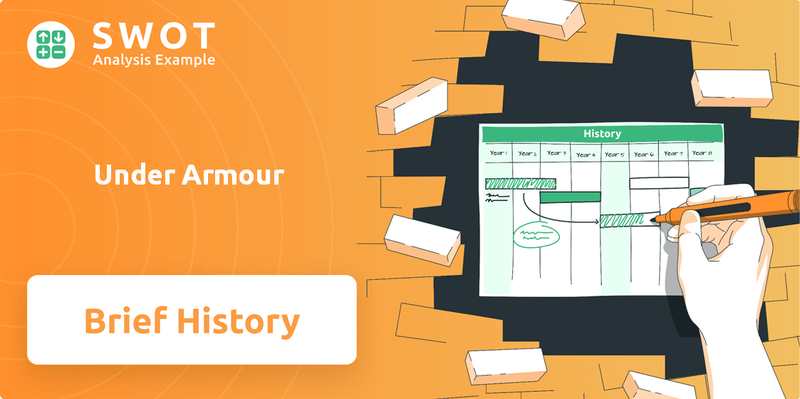
From its roots, the Under Armour company has redefined sports apparel, competing with established giants. This exploration into UA history will examine its founding principles, key growth phases, and the challenges it has navigated. Discover how Under Armour's innovative approach and strategic evolution have shaped its journey in the competitive landscape of the sports apparel market.
What is the Under Armour Founding Story?
The story of the Under Armour company, a leading name in sports apparel, began on September 25, 1996. This Growth Strategy of Under Armour started with a simple observation by founder Kevin Plank, a former athlete who saw a gap in the market for better athletic wear.
Kevin Plank, the Under Armour founder, was a special teams captain for the University of Maryland football team. His frustration with the limitations of cotton T-shirts during his athletic career fueled his vision. The initial goal was to create apparel that would keep athletes dry and comfortable by wicking away moisture.
The company's early days were marked by direct-to-team sales, a hands-on approach that allowed Plank to connect directly with his target market. This strategy helped him understand the needs of athletes and refine his product.
Under Armour's origins are rooted in Kevin Plank's experience as a college football player, where he identified a need for better athletic apparel. The company's initial focus was on creating moisture-wicking shirts to keep athletes dry and comfortable.
- The company was founded on September 25, 1996.
- Kevin Plank, the founder, was a former athlete.
- The first product was the '001' T-shirt, a moisture-wicking garment.
- Initial funding came from personal savings and a loan.
The first product, the '001' T-shirt, was a tight-fitting, moisture-wicking garment designed to address the problem of sweat-soaked cotton shirts. Plank invested about $17,000 of his own money and secured a $40,000 loan from his mother to start the business. This early bootstrapping approach was crucial in establishing the company.
The name 'Under Armour' was chosen after Plank considered 'Body Armor' but rejected it due to a similar-named company. This early decision reflects the brand's focus on protection and performance. Under Armour's early success was built on understanding the needs of athletes and providing innovative solutions.
Under Armour SWOT Analysis
- Complete SWOT Breakdown
- Fully Customizable
- Editable in Excel & Word
- Professional Formatting
- Investor-Ready Format
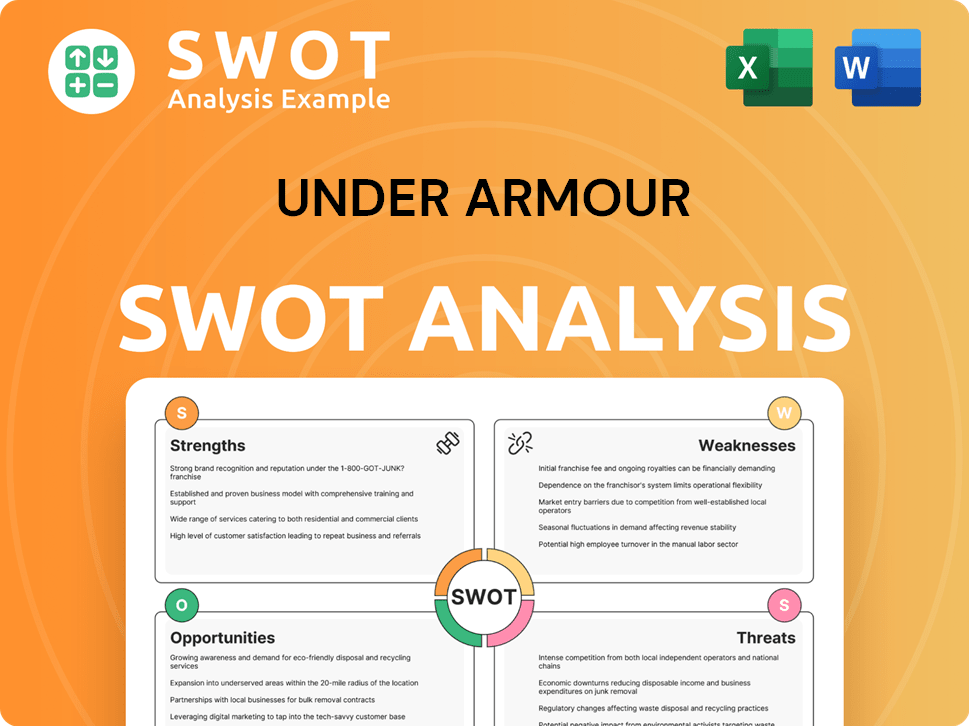
What Drove the Early Growth of Under Armour?
The early growth of the Under Armour company was fueled by its innovative approach to sports apparel and the determined sales tactics of its founder, Kevin Plank. This period, which began with a focus on moisture-wicking shirts, quickly expanded to include a broader range of performance wear. The company's strategy involved securing early sales with sports teams and leveraging strategic marketing to build brand recognition.
After the initial team sale to Georgia Tech, the company gained traction among collegiate and professional football teams. By 1997, the company had moved out of Plank's grandmother's basement into a small warehouse in Baltimore. Revenue reached $1 million by 1998, showcasing the impact of the core moisture-wicking apparel.
The late 1990s and early 2000s saw the company expand its product line beyond just T-shirts. This included a wider range of performance apparel, such as cold-weather gear. The company's product diversification was a key strategy during this period of growth.
A pivotal moment came in 1999 when Warner Bros. licensed the company to provide apparel for its film 'Any Given Sunday,' which significantly boosted brand visibility. In 2003, the company launched its first television commercial, 'Protect This House,' further cementing its brand identity. This strategic marketing played a crucial role in establishing the brand.
The initial public offering (IPO) in 2005 marked a significant milestone, raising over $150 million and providing capital for further expansion. This period also saw the company begin its foray into footwear, launching its first line of athletic shoes in 2006. This financial boost supported the company's growth.
Under Armour PESTLE Analysis
- Covers All 6 PESTLE Categories
- No Research Needed – Save Hours of Work
- Built by Experts, Trusted by Consultants
- Instant Download, Ready to Use
- 100% Editable, Fully Customizable
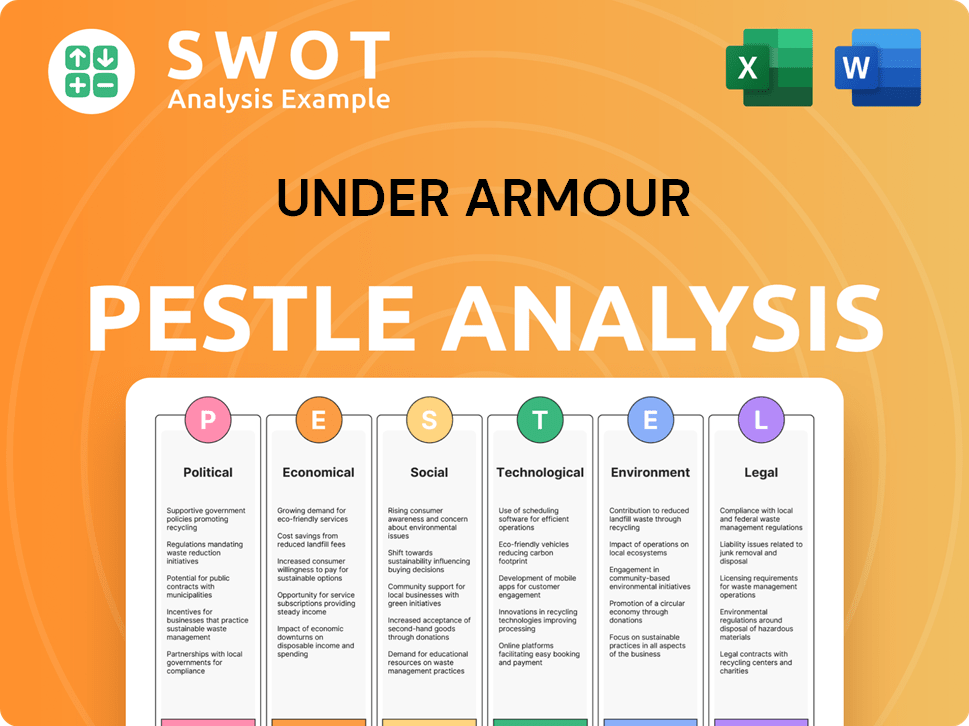
What are the key Milestones in Under Armour history?
The Under Armour company has a rich history filled with significant milestones, innovations, and challenges, shaping its evolution in the sports apparel industry. From its humble beginnings, the company has grown to become a major player, constantly adapting to market dynamics.
| Year | Milestone |
|---|---|
| 1996 | Founded by Kevin Plank, launching with moisture-wicking athletic shirts. |
| 2006 | Launched its first line of athletic footwear, expanding its product categories. |
| 2013 | Acquired MapMyFitness for $150 million, entering the digital fitness market. |
| 2015 | Acquired MyFitnessPal and Endomondo for a combined $560 million, boosting its digital presence. |
| 2020 | Divested MyFitnessPal for $345 million, shifting focus to core apparel and footwear. |
Under Armour's innovations have been central to its growth, starting with its moisture-wicking apparel designed to keep athletes cool and dry. The company expanded its offerings with HeatGear for warm weather and ColdGear for cold conditions, creating a comprehensive system for athletic performance.
The initial innovation that set the company apart, designed to replace cotton shirts and keep athletes dry.
Introduced for warm weather, providing a cooling effect and enhancing performance in hot conditions.
Designed for cold weather, offering insulation and warmth to keep athletes comfortable in cold environments.
Entering the footwear market with innovative designs and technologies to support athletic performance.
Acquisitions of MapMyFitness, MyFitnessPal, and Endomondo aimed to create a connected fitness ecosystem.
Continuous focus on developing apparel and footwear that enhances athletic performance through innovative materials and designs.
Despite its successes, Under Armour has faced several challenges, including intense competition from industry giants like Nike and Adidas. The company experienced a period of slowing growth and profitability concerns in the mid-2010s, leading to restructuring efforts and strategic shifts.
Facing strong competition from established brands like Nike and Adidas, impacting market share and growth.
Changes in consumer trends, including the rise of athleisure wear, requiring adaptation in product offerings and marketing strategies.
Experiencing a period of slower growth and facing challenges in maintaining profitability, leading to restructuring efforts.
Selling MyFitnessPal in 2020 for $345 million, indicating a strategic shift away from large-scale connected fitness ambitions.
Facing scrutiny regarding its internal culture and corporate governance, requiring efforts to improve transparency and accountability.
Navigating changes in the retail environment, including the growth of e-commerce and evolving consumer shopping habits.
Under Armour Business Model Canvas
- Complete 9-Block Business Model Canvas
- Effortlessly Communicate Your Business Strategy
- Investor-Ready BMC Format
- 100% Editable and Customizable
- Clear and Structured Layout
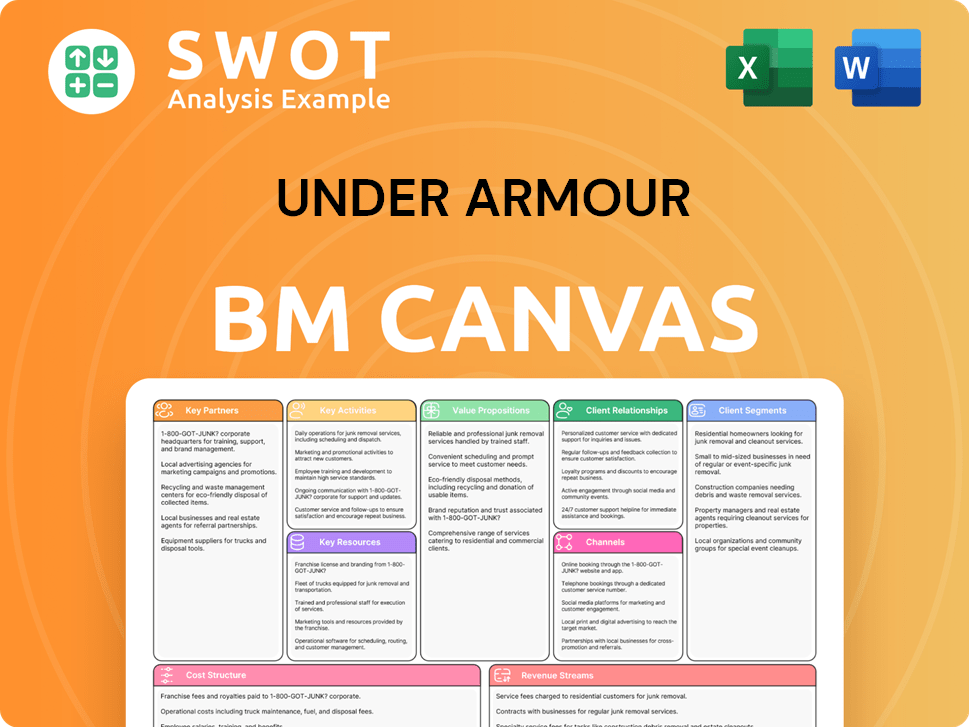
What is the Timeline of Key Events for Under Armour?
The Under Armour's journey began in 1996 when Kevin Plank founded the company, quickly evolving from its moisture-wicking apparel to a global sports apparel brand. The company's growth has been marked by strategic expansions, acquisitions, and a focus on innovation, navigating both successes and challenges in the competitive sports industry.
| Year | Key Event |
|---|---|
| 1996 | Kevin Plank founds Under Armour, marking the company's inception. |
| 1997 | The company relocates to a small warehouse in Baltimore. |
| 1998 | Revenue reaches $1 million, a significant milestone in early growth. |
| 1999 | Under Armour apparel is featured in the film 'Any Given Sunday', increasing brand visibility. |
| 2003 | The 'Protect This House' television commercial launches, enhancing brand recognition. |
| 2005 | Under Armour goes public with an IPO, entering the public market. |
| 2006 | The company introduces its first line of athletic footwear, expanding its product range. |
| 2013 | Under Armour acquires MapMyFitness, expanding into digital fitness. |
| 2015 | MyFitnessPal and Endomondo are acquired, furthering the company's connected fitness strategy. |
| 2016 | Under Armour celebrates its 20th anniversary, reflecting on two decades of growth. |
| 2020 | MyFitnessPal is divested, marking a shift in strategic focus. |
| 2023 | Under Armour reports a revenue of $5.9 billion for the fiscal year. |
| 2024 | Under Armour projects flat to slightly down revenue for fiscal year 2025. |
Under Armour is focusing on strengthening its core categories such as performance apparel and footwear. The company is emphasizing innovation and design to maintain its competitive edge in the sports apparel market. This includes developing new technologies and product lines to meet evolving consumer demands.
Optimizing direct-to-consumer channels is a key strategy for Under Armour to enhance customer engagement. The company aims to improve its online presence and retail experiences. This approach allows for better control over the brand message and customer relationships.
Enhancing Under Armour's global brand presence is a priority for future growth. The company is working to expand its footprint in key international markets. This involves tailoring marketing strategies and product offerings to resonate with diverse consumer bases worldwide.
Under Armour is committed to improving operational efficiency to drive sustainable growth. This includes streamlining processes and optimizing supply chain management. The goal is to reduce costs and improve profitability while maintaining product quality.
Under Armour Porter's Five Forces Analysis
- Covers All 5 Competitive Forces in Detail
- Structured for Consultants, Students, and Founders
- 100% Editable in Microsoft Word & Excel
- Instant Digital Download – Use Immediately
- Compatible with Mac & PC – Fully Unlocked
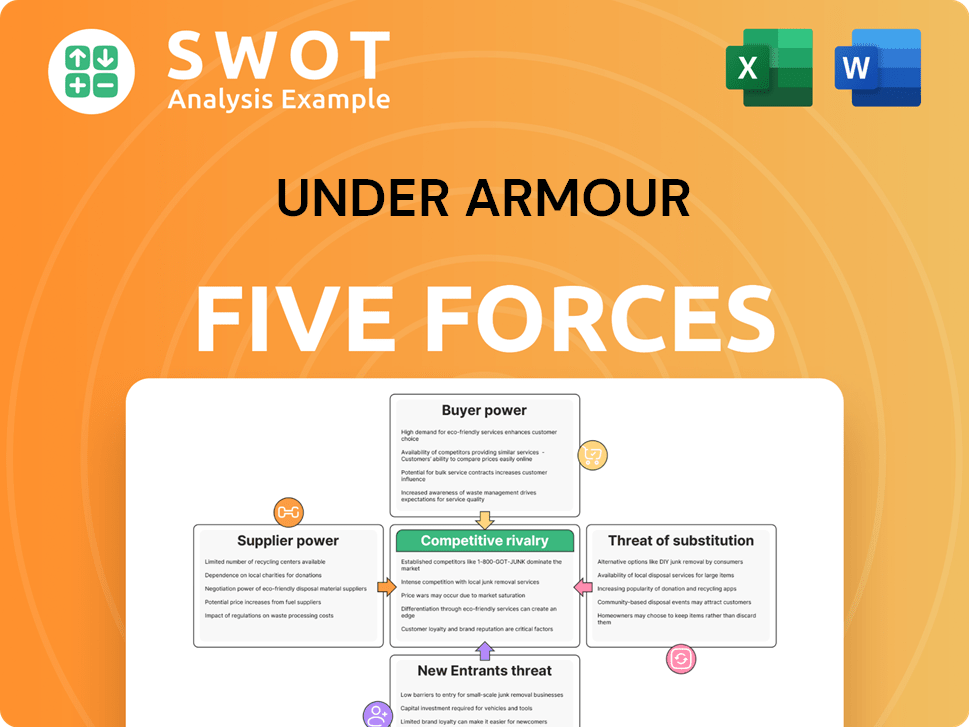
Related Blogs
- What is Competitive Landscape of Under Armour Company?
- What is Growth Strategy and Future Prospects of Under Armour Company?
- How Does Under Armour Company Work?
- What is Sales and Marketing Strategy of Under Armour Company?
- What is Brief History of Under Armour Company?
- Who Owns Under Armour Company?
- What is Customer Demographics and Target Market of Under Armour Company?
Disclaimer
All information, articles, and product details provided on this website are for general informational and educational purposes only. We do not claim any ownership over, nor do we intend to infringe upon, any trademarks, copyrights, logos, brand names, or other intellectual property mentioned or depicted on this site. Such intellectual property remains the property of its respective owners, and any references here are made solely for identification or informational purposes, without implying any affiliation, endorsement, or partnership.
We make no representations or warranties, express or implied, regarding the accuracy, completeness, or suitability of any content or products presented. Nothing on this website should be construed as legal, tax, investment, financial, medical, or other professional advice. In addition, no part of this site—including articles or product references—constitutes a solicitation, recommendation, endorsement, advertisement, or offer to buy or sell any securities, franchises, or other financial instruments, particularly in jurisdictions where such activity would be unlawful.
All content is of a general nature and may not address the specific circumstances of any individual or entity. It is not a substitute for professional advice or services. Any actions you take based on the information provided here are strictly at your own risk. You accept full responsibility for any decisions or outcomes arising from your use of this website and agree to release us from any liability in connection with your use of, or reliance upon, the content or products found herein.